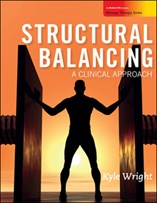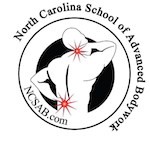
Massage School Course Materials will support your learning experience in Massage School AND serve as vital references throughout your massage & bodywork career.
Our NEXT 500-Hour Professional Class STARTS:Monday, June 2, 2025
Massage Therapy Principles and Practice
by Susan G. Salvo

Susan Salvo’s book will be used for teaching Anatomy & Physiology, Indications & Contraindications, Massage Theory, and so much more . . .
“I have used Salvo’s book for years and her new Edition
will be a great reference for your training here at NCSAB.”
Kyle C. Wright, LMBT, NCTMB
(Monday and Tuesday classes and to be used as a resource for your entire career)
Massage Therapy Principles and Practice,
Sixth Edition
Click the above link to purchase from Amazon, or purchase on campus for $75.
Structural Balancing: A Clinical Approach
by Kyle C. Wright, LMBT, NCTMB
co-Author, David Scott Lynn
 Structural Balancing, A Clinical Approach, was written with the massage therapy students in mind, to encourage each student to explore and expand their study and practice of massage therapy. It is a comprehensive manual on principles, practices, and procedures for delivering clinical massage therapy.
Structural Balancing, A Clinical Approach, was written with the massage therapy students in mind, to encourage each student to explore and expand their study and practice of massage therapy. It is a comprehensive manual on principles, practices, and procedures for delivering clinical massage therapy.
I, Kyle Wright, believe it will be the primary “building block” in your development toward becoming a well-trained clinical massage and bodywork therapist.
(For Wednesday and Thursday classes)
Structural Balancing: A Clinical Approach
Click the above link to purchase from Amazon, or purchase on campus for $75.
Here are descriptions of the content of the book:
Section 1: Foundations
Welcome Chapter: Value of Soft-Tissue Therapy
The chapter offers a brief introduction to the overall benefits of soft-tissue therapy and describes the phenomena of Chronic, Excess Muscle and Nerve Tension (C.E.M.&.N.T.), as well as why it should be recognized as a primary cause of many afflictions that are not effectively treated by other therapies, including more typical massage and bodywork modalities.
Chapters 1-5
In order to apply proper manual techniques, it is important to have a solid understanding of the principles underlying those techniques. An effective process of gathering data is necessary to know where and when to apply those techniques. A clear understanding of Chronic Excess Muscle and Nerve Tension (C.E.M.&.N.T.) and the many symptoms, syndromes, and pain it causes further enhances the therapist’s ability to tailor the strategies for the specific needs of the client. The following foundational chapters will provide the knowledge and insights for the therapist to develop an effective treatment strategy.
Chapter 1: The Components of Structure (Bones and Landmarks)
Chapter 1 involves a palpatory study of the skeletal body to develop hand-placement skills for learning the muscles and their attachments. Topics include a study of the bones and surface features, bony landmarks, bone positioning as it relates to structure and movement, and where and how muscles attach to bones and the paths they travel over the body’s joints
Chapter 2: Structural Analysis and Postural Assessment
Chapter 2 discusses visualizing and analyzing the positioning of the client’s bones in space and their relationship with each other. Topics include observational skills, the application of structural anatomy and postural kinesiology, muscular imbalances, chronic bad postures, the planes of the body, and understanding how structural analysis and postural assessment allow the practitioner to determine causes of pain and dysfunction that are distant from the apparent symptom.
Chapter 3: Muscle Tension and Causes
Chapter 3 offers an in-depth look at the various causes of muscle tension and provides insights into how it can be prevented and how it should be treated.
Chapter 4: Symptoms and Conditions of Muscle Tension
Chapter 4 describes how muscle tension, directly and indirectly, causes specific conditions and symptoms.
Chapter 5: Principles of Reversing Muscle Tension
Chapter 5 provides clinical approaches to soft tissues and chronic tension, including understanding why soft-tissue therapy, when improperly applied, can be ineffective or counter-productive.
Section II: Clinical Massage Therapy and Structural Bodywork
Chapters 6-10
Clinical massage therapy and structural bodywork (at one level) are two different therapy disciplines. The first, clinical massage therapy, involves the ability to understand and effectively identify and manipulate the soft tissues of the body for the purpose of reducing chronic excess muscle tensions that contribute to the onset of pain and dysfunction. Structural bodywork adds a level of sophistication in scientifically tracking down the aches, pains, and dysfunctions that are not sufficiently responsive to localized (at the location of symptoms) treatment of neuromuscular and myofascial structures.
Each chapter contains pertinent information structured in an easy-to-follow format to assist in facilitating the student’s learning of the muscles, origins, insertions, functions, and myotomes. Pain referral patterns associated with each muscle, clinical notes for discussion and reference, patient positioning, and treatment routines are all included.
Chapter 6: Posterior Lower Extremity Compartment (PLEC)
Chapter 6 covers the muscles of the Posterior Lower Extremity Compartment (PLEC) and the related problems that can manifest in muscles of the foot, calf, posterior and lateral thigh, buttock, and hip.
Chapter 7: Anterior Torso Compartment (ATC)
Chapter 7 covers the muscles of the Anterior Torso Compartment (ATC) and the related problems that can manifest in the muscles of the abdomen, chest, anterior neck, and jaw.
Chapter 8: Anterior Lower Extremity Compartment (ALEC)
Chapter 8 covers the muscles of the Anterior Lower Extremity Compartment (ALEC) and the related problems that can manifest in the muscles of the foot, shin, anterior, and medial thigh.
Chapter 9: Posterior Torso Compartment (PTC)
Chapter 9 covers the muscles of the Posterior Torso Compartment (PTC) and the related problems that can manifest in the muscles of the lower, middle and upper back, shoulder and posterior neck.
Chapter 10: Upper Extremity Compartment (UEC)
Chapter 10 covers the muscles of the Upper Extremity Compartment (UEC) and the related problems that can manifest in the muscles of the arm, forearm, and hand.
Features of the Book
and Course Materials
The Clinical Massage Therapy & Structural Bodywork textbook has the following unique features to stimulate the learning process.
Tables: Summarize important information at a glance
Learning Outcomes at the beginning of each chapter prepare the students for important sections for a quick understanding of the chapter’s content.
Overview at the beginning of each chapter provides the students with a glimpse of the chapter’s content
Clinical Success Stories for chapters 6-10 describe real-life situations and the clinical approaches and applications of the work.
Full-Color Photos & Illustrations of the featured techniques and body structures enhance the learning experience with visuals.
OIAM Charts list the individual muscle origins, insertions, actions, and myotomes at a glance for each major muscle.
Clinical Notes describe the key elements and pertinent information about the muscles being treated.
Routines Demonstrate Client Positioning and the proper hand placements for developing the student’s skills for delivering effective clinical massage therapy techniques to the muscles.
Stretching Exercises at the end of chapters 6-10 illustrate safe and effective stretches for improving one’s flexibility.
Brief Summary at the end of each chapter lists key points of the chapter to help students retain what they just learned.
Review Questions at the end of each chapter reinforces the concepts just learned.
Critical Thinking Questions at the end of chapters 6-10 reflect back to the Clinical Success Stories and prompt students to conclude what to do in that situation.
Muscle Index at the end of the book provides the students with a quick reference to find a specific muscle.
A hard-bound spiral cover, which allows the book to lie flat for easy reference while studying or during practical applications.
The OLC provides links to supplemental education materials.
The following appendices have been added at the end of the book with valuable information about the significance that massage and bodywork, chiropractic adjustments, reducing negative thought processes of the mind-body, and strength training, are all connected in the healing process. This material will assist the student’s awareness and understanding of just some of the other disciplines that support the combined overall healing of the mind-body. Also, a visual muscle appendix has been added to show some of the various muscles for different sections of the body to aid in the visual learning process for the students.
These Appendices Include:
- Appendix A: Muscles of the Body
- Full Body
- Posterior Lower Extremity Compartment (PLEC)
- Anterior Torso Compartment (ATC)
- Anterior Lower Extremity Compartment (ALEC)
- Posterior Torso Compartment (PTC)
- Upper Extremity Compartment (UEC)
- Appendix B: Chiropractic and Massage by Dr. Kelly Huber
- Appendix C: Mind and Body Connection by Robert J. Rotella, Ph.D.
- Appendix D: Strength Conditioning by Vance Ferrigno, CSCS
